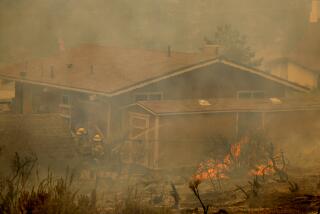Logging Doesn’t Control Fire
Logging alone won’t solve the devastating fire problem in the Sierra. Between 1980 and 1990, the Forest Service harvested [billions of] board feet of timber, but still the forests burned hotter and more extensively than any other time in living memory.
Even the most conscientious logging operation leaves tons of flammable “slash”--limbs, broken poles, crushed brush and splintered wood. Slash chokes steep canyons and covers hillsides with a dry, flammable carpet 10 feet thick or more. Big fires don’t start in healthy stands of commercial timber; they start in rotten snags surrounded by thick deadwood or in tall, decadent brush fields. Logging does little to control the conditions that lead to fire.
In fact, without proper post-harvest fuels control, logging makes the fire problem worse. In the old days, the Forest Service employed brush crews to gather up slash and brush to burn in the fall after the first rains. In the last 20 years, brush crews have almost disappeared from the forests. Recently, the Forest Service has experimented with aerial application of herbicides to control post-logging and post-fire brush growth, but with little success.
Sometimes the old, labor-intensive ways are the best. The native population of the Sierra--the Miwok, Mono and Yokut people--practiced this: They gathered firewood, hand-cleared around oak trees and burned the forest floor on a regular basis to keep the deadwood low and the forests safe and healthy. Logging alone won’t prevent catastrophic fires; we must return to cultivating and tending our forests as well.
Sally Johnson
Fresno
*
President Bush is trying to enact new, common-sense laws to allow logging in our national forests. It disturbs me to read the position of the environmental groups. They claim the logging companies will only log out the big trees and leave the “junk brush” and little trees. It is in the best interest of the logging companies to remove this low growth for three reasons: to get in to the trees and work; for the new seedlings that they will be planting to grow, thus ensuring them future crops of trees; in case of fire, so it won’t have fuel to spread and destroy their future crops.
I grew up in Marin County and for the past six years have lived in the foothills near Sequoia National Forest. We who live near and in the forest understand the environment. When I come back to the Bay Area and talk to people there, they are so ignorant of the true ways to preserve the forests--they just believe the nonsense of the environmental groups.
Mayra S. Paldon
Badger, Calif.
*
As a longtime Forest Service biologist, I have witnessed firsthand the sad condition of our national forests. The reasons the forests are in such sad shape are the over-harvesting of large, fire-resistant trees for profit and allowing kindling to build up along with dense stands of a monoculture tree-farm-like imitation forest, while extinguishing every fire for 50 years.
Thinning should be focused in all areas of the forests where there are roads and previous harvesting histories. No new roads or old growth should be included in this plan.
We should fix what we have mismanaged and not continue to deny the facts based on profit incentive. It is time to get real on this issue. If the Forest Service continues to try to sell old-growth timber where little remains, the problem will only worsen.
Mark A. York
Sunland
*
I have to commend Bush on his consistency. Whenever there is an opportunity to push forward the short-term interests of corporate profits at the expense of our nation’s wildlife (and the American people), he pounces on it. His latest proposal to prevent forest fires by cutting down forests is made even more shameful by his transparent claims to be concerned about the environment. Bush is only concerned with selling our natural resources at discount prices to his corporate friends.
Julian Scaff
Monrovia
*
Rather than waiving environmental laws so the timber industry can log more big trees in the back country, the administration should protect communities close to our national forests that are at unnecessary risk from fire.
The Forest Service should ensure that 90% of the expenditures on fuel reduction in national forests occurs within 500 meters of a community’s buildings, the area known as the community protection zone.
The Bush administration should start protecting communities and national forests rather than the profits of the timber industry. Congress should reject the Bush administration’s Healthy Forests Initiative.
Tiernan Sittenfeld
Conservation Advocate
California Public Interest
Research Group, Washington
More to Read
Sign up for Essential California
The most important California stories and recommendations in your inbox every morning.
You may occasionally receive promotional content from the Los Angeles Times.










